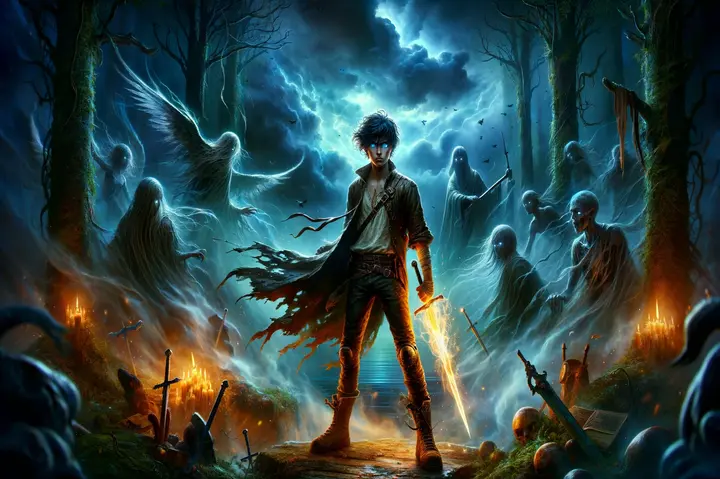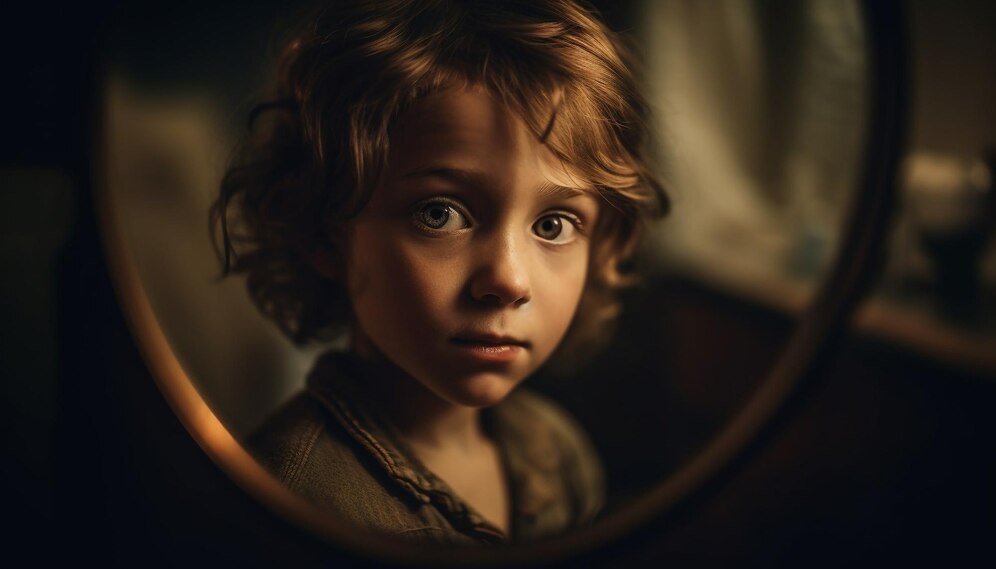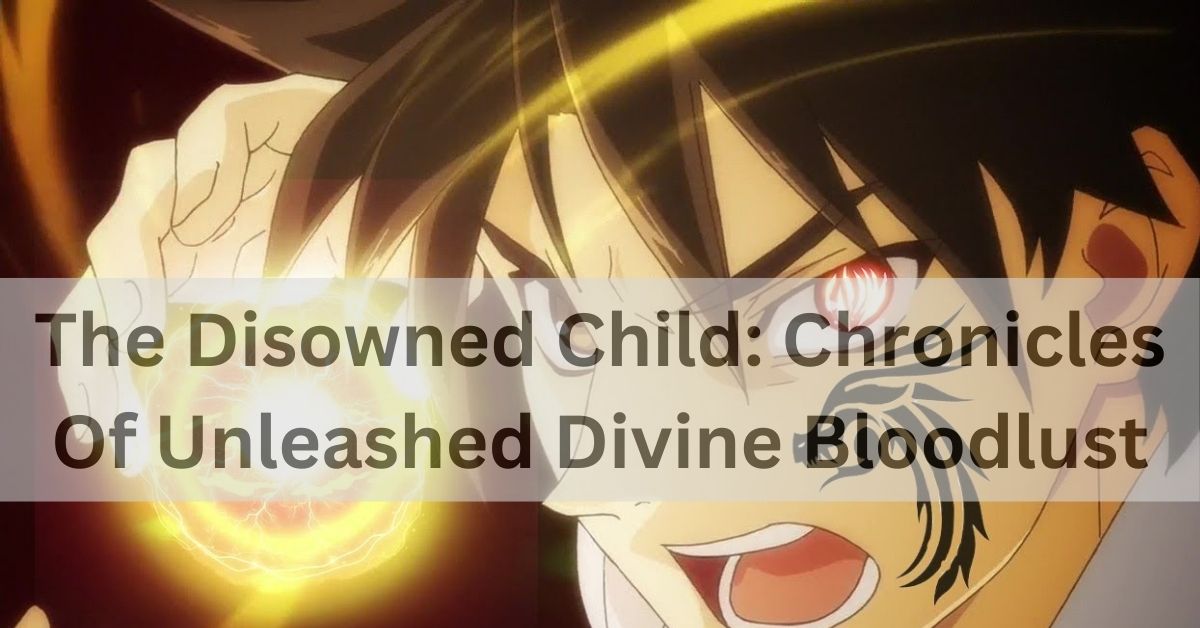In the world of fantasy books, the idea of the “disowned child” is a powerful and intriguing one. This character, who is often caught between the human and divine worlds, represents a deep story about identity, power, and redemption.
Table of Contents
The Disowned Child: A Classic Figure Reimagined
At the center of The Disowned Child is Alaric, a young man who perfectly fits the “disowned child” role. Alaric’s story is about trying to understand who he really is. Rejected by his family and given incredible divine powers, he faces a tough journey of self-discovery and acceptance.

Kingsley’s portrayal of Alaric goes beyond traditional fantasy. Alaric isn’t just someone who has been wronged; he’s someone struggling to balance his new, supernatural abilities with his own desires and fears. His journey isn’t just about overcoming obstacles but also about understanding himself and finding his place in the world.
The Divine Bloodlust: A Unique Twist
One of the main themes in the novel is divine bloodlust, a fresh take on ancient myths about wrath and power. Alaric’s newfound power comes with an uncontrollable craving for blood, which represents his internal struggle between his base desires and his higher goals.
Kingsley blends elements of horror and mythology to create a story that explores the darker side of divine gifts. This bloodlust is both a curse and a challenge for Alaric, symbolizing the conflict between his raw desires and his quest for control. Through Alaric’s struggle, the novel delves into the nature of power and its impact on who we are.
Read Also: Phillipa Mariee – Wwe’s Rising Star And Her Journey To Fame!
Character Development: The Heart of the Story
Alaric: The Disowned Child
Alaric’s growth throughout the novel is one of its most compelling aspects. His transformation from a rejected youth to a powerful figure is both engaging and relatable. Kingsley makes Alaric a character with depth, showing both his vulnerabilities and strengths.
Alaric’s interactions with others are crucial to his development. His mentor, Alistair, helps him navigate his powers and the ethical dilemmas they bring. Elara, his loyal friend, supports him emotionally, highlighting the importance of friendship and trust. These relationships help Alaric grow, making his journey not just about mastering his powers but also about understanding himself and his role in the world.
Lady Seraphina: The Mysterious Villain
Lady Seraphina, the main antagonist of the story, adds complexity to the plot. Driven by ambition and a desire for control, she contrasts sharply with Alaric’s quest for acceptance. Her character challenges Alaric on many levels, pushing him to face both external threats and his internal conflicts.
Kingsley presents Seraphina as a deeply ambitious and manipulative character. Her actions and schemes are significant obstacles for Alaric, and her role highlights the themes of power and moral choices. The conflict between Alaric and Seraphina adds depth to the story, exploring the balance between good and evil.
Themes and Lessons: Exploring Deeper Meanings

Identity and Self-Discovery
At its core, The Disowned Child is about discovering who you really are. Alaric’s journey is a metaphor for the search for personal meaning and purpose. His struggle to balance his divine heritage with his personal desires mirrors the universal quest for self-acceptance and fulfillment.
Kingsley explores how identity is shaped by experiences, relationships, and personal choices. Alaric’s story invites readers to think about their own journeys of self-discovery and the challenges they face in understanding themselves.
Family and Betrayal
Family dynamics and betrayal are important themes in the novel. Alaric’s rejection by his parents sets the stage for his journey and highlights the impact of family relationships on personal growth. Kingsley explores these themes with sensitivity, showing how misunderstanding and fear can lead to estrangement.
The novel portrays the emotional weight of betrayal and abandonment, emphasizing how familial rejection can shape one’s path. This adds depth to Alaric’s journey, making his struggles with family both personal and poignant.
Destiny vs. Free Will
The novel also tackles the debate between destiny and free will. Alaric’s journey involves balancing divine expectations with his own choices, reflecting the broader philosophical question of fate versus autonomy.
Kingsley explores how Alaric’s decisions and actions challenge the idea of a predetermined path. The story emphasizes personal agency and the role of choice in shaping one’s future, inviting readers to consider how fate and free will interact in their own lives.
Impact on Readers: A Powerful Experience
Immersive World-Building
One of the standout features of The Disowned Child is its detailed world-building. Kingsley creates a vivid fantasy world that draws readers in with its rich settings and dynamic elements. The novel’s environment, from grand cities to mystical creatures, is described with such detail that it feels real and engaging.
This immersive world-building allows readers to fully experience Alaric’s adventures and the story’s magical elements. Kingsley’s ability to create a believable and captivating world adds to the novel’s appeal and makes it an exciting read.
Emotional Resonance
Beyond its fantasy elements, The Disowned Child touches readers emotionally. Kingsley’s portrayal of Alaric’s journey is deeply affecting, exploring themes of identity, power, and redemption with sensitivity.
The novel’s emotional depth comes from its exploration of relatable struggles. Alaric’s experiences with loss, betrayal, and self-discovery mirror the universal human experience, allowing readers to connect with his story on a personal level.
Read Also: Mysdmc Sso – Simplifying Access To Educational Tools!
Critical Reception:
The Disowned Child
Chronicles of Unleashed Divine Bloodlust has received praise from critics for its originality and depth. The novel’s blend of mythology and modern storytelling has been recognized for its creativity and compelling narrative.
Awards and Recognition
The novel has won several awards, including:
- The Mythic Prize for Best Fantasy Novel
- The Aurelia Award for Outstanding World-Building
- The Caliburn Award for Best New Author
- These accolades highlight the novel’s success and its impact on the world of fantasy literature.
Literary Analysis:
The novel has inspired a range of discussions among literary scholars, who explore its themes and significance. Key areas of analysis include:

- Identity and Self-Discovery: How the novel’s exploration of identity reflects broader human experiences and the quest for meaning.
- Symbolism and Mythology: The use of mythological elements and symbolism to enrich the story’s themes and narrative.
- Power and Redemption: The depiction of power and its impact on personal growth and redemption.
FAQs:
1. What inspired Sarah J. Kingsley to write The Disowned Child?
Sarah J. Kingsley drew inspiration from classic myths and modern psychological themes, blending them to explore personal identity and divine power in a fresh narrative.
2. How does the novel incorporate elements of horror into its fantasy setting?
The novel uses divine bloodlust as a central theme, infusing the story with elements of horror through Alaric’s struggle with his uncontrollable cravings, adding a darker dimension to the fantasy genre.
3. What role does Alaric’s mentor, Alistair, play in the development of the story?
Alistair serves as both a guide and a moral compass for Alaric, helping him navigate his newfound powers and make crucial decisions about his path and responsibilities.
4. How does Lady Seraphina’s ambition affect the plot?
Lady Seraphina’s ambition drives the central conflict, challenging Alaric and creating obstacles that force him to confront his fears and the true nature of his powers.
5. What are some of the critical themes explored through Alaric’s relationships with other characters?
Alaric’s relationships highlight themes of trust, friendship, and betrayal, illustrating how personal connections can influence one’s journey and shape character growth.
Conclusion:
The Disowned Child: Chronicles of Unleashed Divine Bloodlust captivates with its fresh take on the “disowned child” archetype, blending divine power and personal struggle. Sarah J. Kingsley’s vivid storytelling and intricate world-building create a compelling narrative of self-discovery and redemption. The novel’s exploration of identity and power resonates deeply, making it a standout in fantasy literature.
Read Also:

![Jarreth Plunkett - A Comprehensive Overview! Introduction: Jarreth Plunkett is a notable individual whose work and contributions have made a significant impact in his field. This article provides an in-depth look at Jarreth Plunkett’s background, achievements, and the influence he has had. Whether you are familiar with his work or new to his story, this guide will offer valuable insights into his professional journey and accomplishments. Who is Jarreth Plunkett? Early Life and Education Jarreth Plunkett was born and raised in a vibrant community that nurtured his early interests and talents. His journey began with a strong educational foundation, which set the stage for his future success. Plunkett pursued his studies with enthusiasm, showing a particular interest in [specific field or subjects related to his career, if known]. His education played a crucial role in shaping his career path and personal growth. Career Beginnings Jarreth Plunkett’s career began with modest steps, but his dedication and skill quickly set him apart. Early in his career, he took on various roles that allowed him to build experience and demonstrate his capabilities. His initial work focused on [specific roles or industries], where he honed his skills and developed a reputation for excellence. Together We can Strengthen our Communities: "Together We Can Strengthen Our Communities" reflects the belief that collective effort and collaboration are essential for improving and supporting local communities. This principle is often championed by individuals like Jarreth Plunkett, who work to unite people and organizations towards common goals. Jarreth Plunkett is known for his commitment to community development and leadership. His efforts focus on fostering partnerships and creating programs that address various social issues. By encouraging community involvement and leveraging the strengths of diverse groups, Plunkett aims to build stronger, more resilient communities. His work exemplifies how collaborative approaches can lead to meaningful and sustainable improvements in local areas. Major Achievements Notable Projects and Contributions: "Together We Can Strengthen Our Communities" embodies the idea that collective effort and collaboration are key to enhancing and supporting local communities. Jarreth Plunkett is a proponent of this approach, emphasizing the importance of working together to address community challenges and create positive change. Through his initiatives, Plunkett focuses on uniting individuals and organizations to tackle social issues, foster local development, and build stronger, more resilient communities. His work highlights how teamwork and shared commitment can lead to impactful solutions and improve the overall well-being of communities. Major Achievements: Jarreth Plunkett has achieved several notable milestones in his career, reflecting his dedication to community development and leadership. His major achievements include: Community Leadership: Plunkett has been recognized for his exceptional leadership in various community projects. His efforts in organizing and spearheading initiatives have significantly contributed to local development and support. Advocacy and Outreach: He has played a crucial role in advocating for important social issues and raising awareness. Through his outreach programs, Plunkett has mobilized resources and engaged community members to address pressing concerns effectively. Program Development: Plunkett has been instrumental in creating and implementing programs aimed at improving community welfare. These programs often focus on areas such as education, health, and economic development, providing valuable resources and support to those in need. Partnership Building: One of his key achievements is his ability to build strong partnerships with various organizations and stakeholders. By fostering collaboration, Plunkett has enhanced the impact of community initiatives and ensured sustainable outcomes. Recognition and Awards: His work has earned him recognition and awards from various organizations, underscoring his commitment and contributions to community service. Jarreth Plunkett’s achievements reflect his dedication to strengthening communities and making a positive difference through effective leadership and collaborative efforts. Impact and Influence: Jarreth Plunkett has had a significant impact and influence through his work in community development and leadership. His efforts have shaped and strengthened local communities by addressing critical social issues and fostering collaborative partnerships. Plunkett’s initiatives have led to tangible improvements in areas such as education, health, and economic development, providing essential support and resources to those in need. His ability to unite individuals, organizations, and stakeholders has amplified the effectiveness of community programs and driven meaningful change. Through his advocacy and outreach, Plunkett has raised awareness of important causes and mobilized collective action, demonstrating his profound influence on enhancing community well-being and resilience. Personal Life and Interests: Jarreth Plunkett’s future goals and aspirations are centered around furthering his impact on community development and social change. He aims to expand his efforts in addressing pressing social issues by developing innovative programs and initiatives that meet evolving community needs. Plunkett is committed to strengthening existing partnerships and building new ones to enhance the effectiveness of his projects. Additionally, he aspires to inspire and mentor the next generation of community leaders, sharing his experience and knowledge to empower others. His vision includes continuing to drive positive change, fostering resilience, and promoting sustainable development within communities. Through these goals, Plunkett seeks to create lasting, meaningful improvements and contribute to a more equitable and supportive society. Become an AmeriCorps Member: Jarreth Plunkett’s involvement with AmeriCorps reflects his commitment to service and community development. As an AmeriCorps member, Plunkett has dedicated his efforts to addressing critical community needs through national service programs. His role includes engaging in various projects that focus on improving education, health, and economic opportunities for underserved populations. By participating in AmeriCorps, Plunkett has contributed to meaningful initiatives that support local communities, while also gaining valuable experience and skills in leadership, project management, and public service. His work with AmeriCorps exemplifies his dedication to making a positive impact and fostering community resilience through hands-on, service-oriented activities. Homa Hills residents asked to prepare for possible evacuation with wildfires in the vicinity? Aarreth Plunkett has been actively involved in supporting Homa Hills residents as they prepare for potential evacuations due to nearby wildfires. Recognizing the urgency of the situation, Plunkett has worked to provide crucial information and resources to help residents stay safe. His efforts include coordinating with local emergency services, disseminating evacuation plans, and ensuring that the community is aware of the necessary precautions. By addressing the immediate needs of those affected and promoting preparedness, Plunkett aims to minimize the impact of the wildfires and enhance the overall safety and resilience of the Homa Hills community. Faq’s 1. Who is Jarreth Plunkett? Jarreth Plunkett is a professional known for his significant work in [specific field or industry, e.g., technology, business]. He has built a notable career through his impactful contributions. 2. What is Jarreth Plunkett known for? He is recognized for his achievements in [specific area, e.g., innovative product development, strategic leadership]. His work has made a considerable impact in his industry. 3. What are some of Jarreth Plunkett’s major achievements? Jarreth Plunkett’s key achievements include [list specific projects or milestones, e.g., successful product launches, groundbreaking research]. These accomplishments highlight his expertise and influence. 4. Where did Jarreth Plunkett receive his education? Jarreth Plunkett studied at [mention educational institutions, e.g., Harvard University, MIT]. His education provided a solid foundation for his career in [specific field or industry]. 5. What kind of projects has Jarreth Plunkett worked on? He has worked on various projects such as [describe types or examples, e.g., developing new technologies, leading major business initiatives]. These projects demonstrate his skills and dedication. Conclusion Jarreth Plunkett's career highlights his exceptional dedication and influence in his field. His innovative work and leadership have left a lasting impact, inspiring progress and excellence. Plunkett’s legacy reflects his commitment to both his profession and the success of others. jarreth plunkett](https://vergestation.com/wp-content/uploads/2024/09/ssssss-18-min.png)

